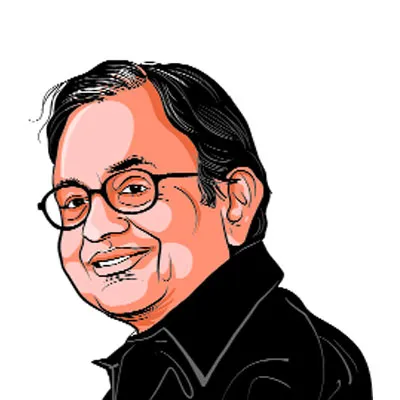Opinion P Chidambaram writes: Delimitation Dilemma
The promise that the number of seats of the Southern states will not be reduced is a hollow promise. Please note that there is no promise that the number of seats of the most populous states — Uttar Pradesh, Bihar, Rajasthan and Madhya Pradesh — will not be increased
 A census after 2026 would mean that delimitation must follow. (Express Photo)
A census after 2026 would mean that delimitation must follow. (Express Photo) Delimitation is a sword hanging over the states’ necks since the 42nd Amendment to the Constitution of India in 1977. Articles 81 and 82 of the Constitution are in clear language: they incorporate the principle of ‘one citizen, one vote’.
Article 81 puts a cap on the number of members of the Lok Sabha at not more than 530 chosen from the States and not more than 20 chosen from the Union Territories (UT). The current numbers are 530 for the States and 13 for the UTs.
Sub-article (2)(a) reads: “there shall be allotted to each State a number of seats in the House of the People in such manner that the ratio between that number and the population of the State is, so far as practicable, the same for all States.”
The expression “population” means the population ascertained at the last preceding census, provided that until the first census taken after 2026, the population of the States shall be the numbers as per the 1971 census. Article 81 requires that after every census the number of seats allotted to a State shall be re-determined, but the exercise was paused until the census taken after 2026. Hence, the number of seats allotted to various States were frozen as they were in 1971 breaching the ‘one citizen one vote’ principle.
Democracy & Federalism
There is no doubt that ‘one citizen, one vote’ is a basic principle of democracy but, as the Americans realised in 1776, it is contrary to the principle of federalism. They found a solution that seems to have served them well in the last 250 years. They re-determined from time to time the seats allotted to each of the 50 states in the House of Representatives on the basis of the population of the state, but gave equal representation (2 members) to each state in the Senate. India, like the US, is a democracy and a federation. We discovered the pitfalls of representation by proportion-of-population in 1971 but instead of finding a solution we kicked the can down the road until 2026.
The last census was held in 2011. The next census was due in 2021, but was postponed on account of COVID-19. A census has not been conducted since 2021 on one pretext or other. A census after 2026 would mean that delimitation must follow; re-determination of the number of seats allotted to each State will follow; and some States will be rewarded for the rapid growth of population and some States will be punished for attaining a total fertility rate (TFR) of 2.0 or below. The inequity of ‘one citizen, one vote’ will hit you on the head.
Reduce & Increase
If the total number of seats in the Lok Sabha is frozen at 530+13 and delimitation and re-determination are done as per Articles 81 and 82, the Southern states (Andhra Pradesh, Karnataka, Kerala, Tamil Nadu and Telangana) will lose badly. Their total number is estimated to come down from 129 to 103. Any manner of applying the principle of proportion-of-population to determine the number of seats in the Lok Sabha for states will ‘punish’ the states that have done well in reducing the fertility rate and stabilising their population — which was a national goal for over 50 years and still is. Today, the Southern states have a voice equal to 129/543 in the Lok Sabha, and it is not vocal enough. If the fraction is reduced to 103/543, the voice of the Southern states will be further diminished.
The promise that the number of seats of the Southern states will not be reduced is a hollow promise. Please note that there is no promise that the number of seats of the most populous states — Uttar Pradesh, Bihar, Rajasthan and Madhya Pradesh — will not be increased. If both ‘no reduction’ and ‘increase’ must be effected through re-determination of seats, the only way it can be done is to substantially increase the number of elected members in the Lok Sabha. Anticipating — and planning for — such an eventuality, the new chamber of the Lok Sabha has been cleverly designed to seat 888 members. If that route is taken to re-determination of seats, the voice of the Southern states will be considerably diminished — from 129/543 (23.76 per cent) to 129/888 seats (14.53 per cent).
Either way, it is too high a price to pay for adherence to the principle of ‘one citizen, one vote’. It is also an unacceptable price to pay for reducing the fertility rate and stabilising the population. The current total fertility rates (source: NHFS-5) of select states will tell the story:
Low High
Andhra Pradesh 1.70 Bihar 3.0
Karnataka 1.70 Uttar Pradesh 2.35
Kerala 1.80 Madhya Pradesh 2.0
Tamil Nadu 1.80 Rajasthan 2.0
Telangana 1.82
Losers & Gainers
In terms of the voice of the state in the Lok Sabha, the low TFR states will be the losers and the high TFR states will be the gainers. The membership of the Rajya Sabha is already skewed in favour of the more populous States. If the central government sticks to the letter of Articles 81 and 82 of the Constitution and the Southern states stick to their opposition to re-determination based on population, it will be a case of an irresistible force facing an immovable object. Discord and disaster will follow. Do we have the wisdom to seek an amicable resolution?





